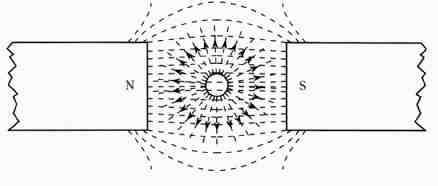AMAZON multi-meters discounts AMAZON oscilloscope discounts
.Thus far, in our imaginary search for motor action, we have come tantalizingly close to the desired result. The interaction of electric charge fields provided such food for thought. Tremendous forces are associated with charge accumulations, but so are tremendously high voltages. Charges measured in tiny fractions of a coulomb still involve tens of kilovolts of potential difference, but they yield motor forces (torques) of not many tens of ounce inches. The electrostatic voltmeter, although incapable of continuous rotation, was cited as an example.
The interaction of magnetic force fields is also stimulating to the imagination, because forceful movements could be produced without any danger of disrupting the air. (Extremely powerful magnetic fields produced by superconducting magnets still impose no breakdown mechanism on nonmagnetic or paramagnetic substances, such as the gasses comprising the atmosphere.) It was pointed out that there is apparently no way in which continuous rotation can be brought about by any arrangement of permanent-magnet poles. This is frustrating, but the immense forces available from even small magnets make it difficult to part with the notion of using magnetic fields. In view of these situations, our investigations might next be expected to focus on interactions between electric charges and magnetic fields. Per haps, the best features of both force fields can thus be made available.

FIG. 8 Stationary magnetic field does not affect the electrostatic field
of a fixed charge.
A good starting point would be the evaluation of force imparted to a fixed uni-pole of electric charge situated in the interpolar field of a strong permanent magnet. The charge could be on a small aluminum sphere suspended by a nylon thread. If the sphere were slowly lowered into the magnetic field, exactly nothing would happen. The purist might object to this statement because the electric lines of force would no longer remain nice and symmetrical as depicted in FIG. 8. However, the distortion of the electric field would be no different than that produced by a “dummy magnet,” say a soft-iron structure that had been completely demagnetized. And while the charge was being lowered into position, the charge would be moving, rather than static. But, if this were done slowly, it would not alter the basic idea revealed by the experiment—that a fixed charge situated in a stationary magnetic field experiences no mechanical force. In the performance of this experiment, it is desirable that the sphere be small, that the magnet poles be widely separated, and that the sphere be carefully lowered midway between the poles. (Otherwise, the sphere might move to one pole or the other because of electrostatic attraction.) Thus far, our hoped-for merger between electric and magnetic forces shows no prospect for realization.